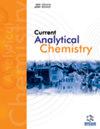Dye Removal Ability of Pure and Doped Graphitic Carbon Nitride
IF 1.7
4区 化学
Q3 CHEMISTRY, ANALYTICAL
引用次数: 2
Abstract
Rapid escalation in textile, paper, pesticides, pharmaceuticals and several other chemical based manufacturing industries due to amplification in human requirements have proportionately contributed to the extreme contamination of water ecosystem, resulted from the discharge of toxic pollutants from industries. Effluents from textile industries are comprised of coloured dyes like Rhodamine B, Methyl Orange, Methylene Blue and phenolic compounds which deserve special mention owing to their non-biodegradable, carcinogenic and severe detrimental nature. Urgent needs to ameliorate this fast declining environmental situation are of immense necessity in current scenario. Objectives: In this regard, graphitic carbon nitride (GCN) is a distinguished material for water purification-based applications because of its exclusive characteristics making it highly prospective for degradation of toxic dyes from water by catalysis and adsorption techniques. GCN has been a material of conspicuous interest in recent times owing to its two dimensional sheets like structure with favourable surface area, and cost-effective synthesis approaches along with high production yield. This article presents a detail study of different aspects of GCN as a material of potential for water purification. Through extensive literature survey it has been shown that GCN is an effective material to be used in the fields of application. Several effective procedures like catalysis or adsorption for removal of dyes from water have been discussed with their basic science behind. This systematic effort shows that GCN can be considered to be one of the most efficient water purifier with further advantages arising from its easy and cost effective large scale synthesis.纯和掺杂石墨氮化碳的脱染能力
由于人类需求的增加,纺织、造纸、农药、制药和其他几个以化学为基础的制造业的快速发展,成比例地造成了水生态系统的极端污染,这是由工业排放的有毒污染物造成的。纺织工业的废水由罗丹明B、甲基橙、亚甲基蓝和酚类化合物等有色染料组成,这些染料由于其不可生物降解、致癌和严重有害的性质而特别值得一提。在目前的情况下,迫切需要改善这种迅速恶化的环境状况。在这方面,石墨氮化碳(GCN)是一种独特的水净化材料,因为它的独特特性使它通过催化和吸附技术降解水中的有毒染料具有很高的前景。近年来,GCN因其具有良好表面积的二维片状结构,以及具有高产量的高成本效益的合成方法而成为一种引人注目的材料。本文介绍了GCN作为潜在的水净化材料的不同方面的详细研究。通过广泛的文献调查表明,GCN是一种有效的材料,可用于应用领域。讨论了催化、吸附等几种去除水中染料的有效方法,并对其基础科学原理进行了分析。这一系统的努力表明,GCN可以被认为是最有效的净水器之一,其进一步的优势源于其简单和成本有效的大规模合成。
本文章由计算机程序翻译,如有差异,请以英文原文为准。
求助全文
约1分钟内获得全文
求助全文
来源期刊

Current Analytical Chemistry
化学-分析化学
CiteScore
4.10
自引率
0.00%
发文量
90
审稿时长
9 months
期刊介绍:
Current Analytical Chemistry publishes full-length/mini reviews and original research articles on the most recent advances in analytical chemistry. All aspects of the field are represented, including analytical methodology, techniques, and instrumentation in both fundamental and applied research topics of interest to the broad readership of the journal. Current Analytical Chemistry strives to serve as an authoritative source of information in analytical chemistry and in related applications such as biochemical analysis, pharmaceutical research, quantitative biological imaging, novel sensors, and nanotechnology.
 求助内容:
求助内容: 应助结果提醒方式:
应助结果提醒方式:


